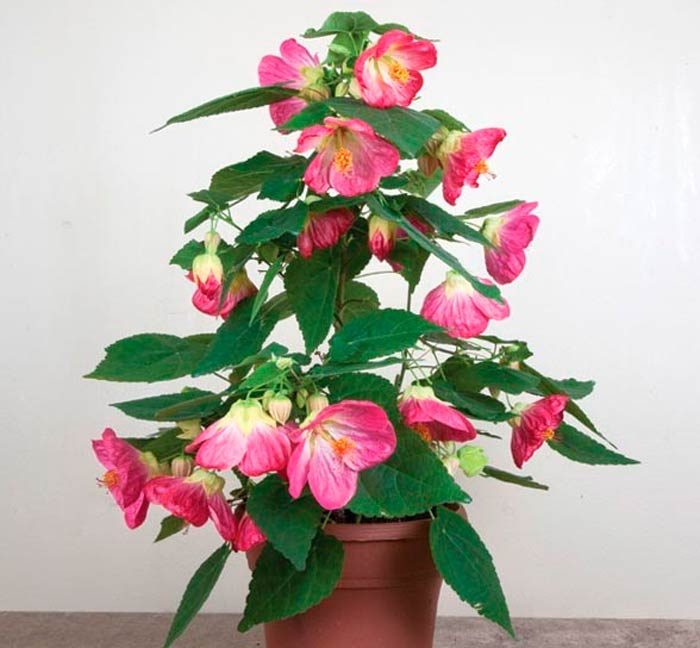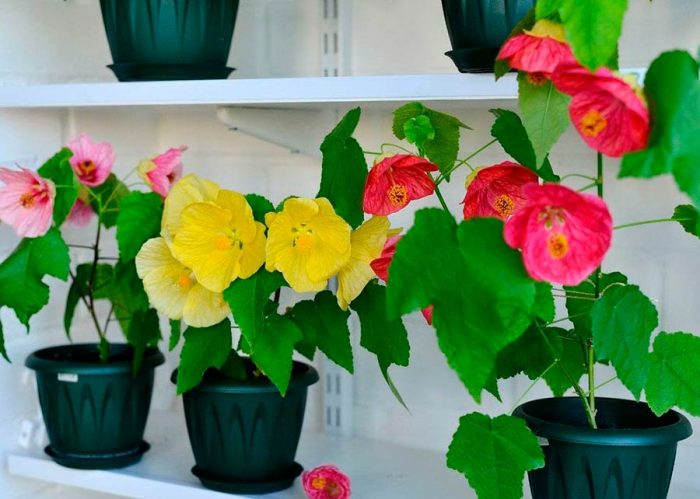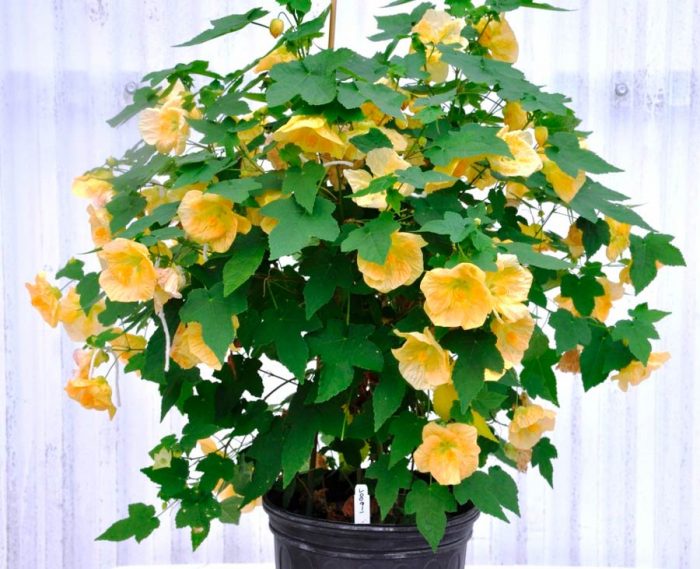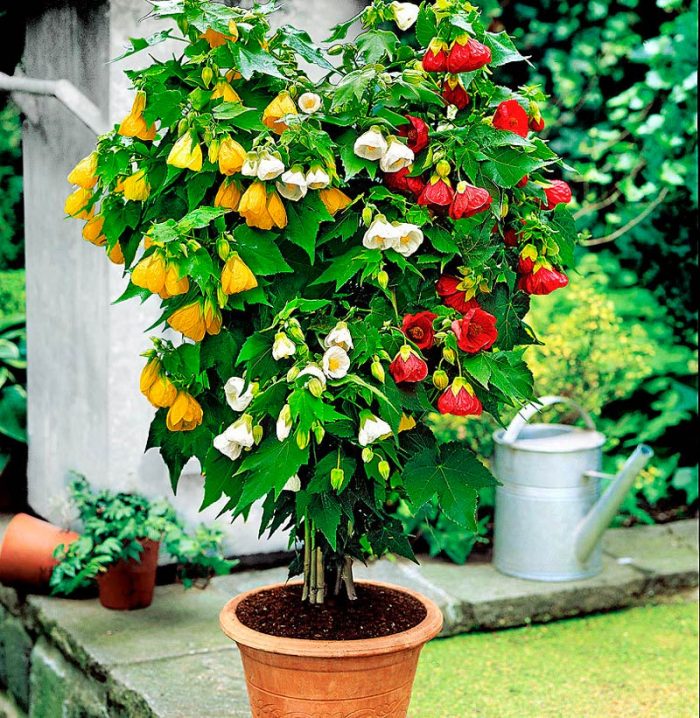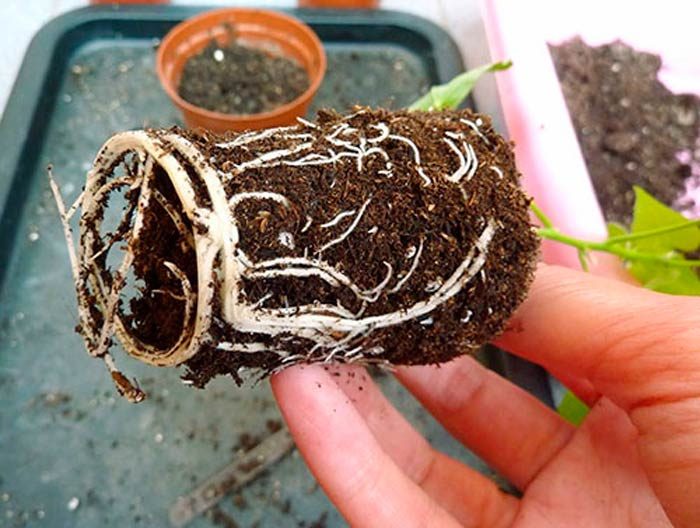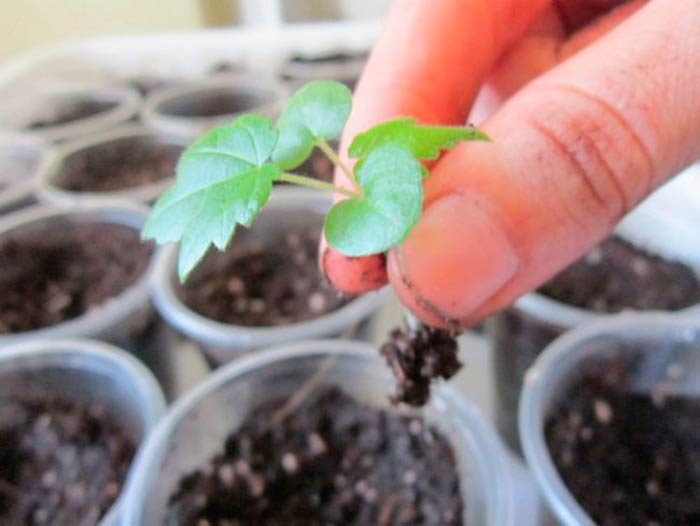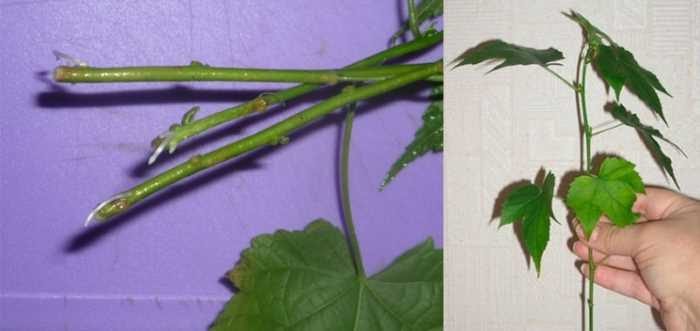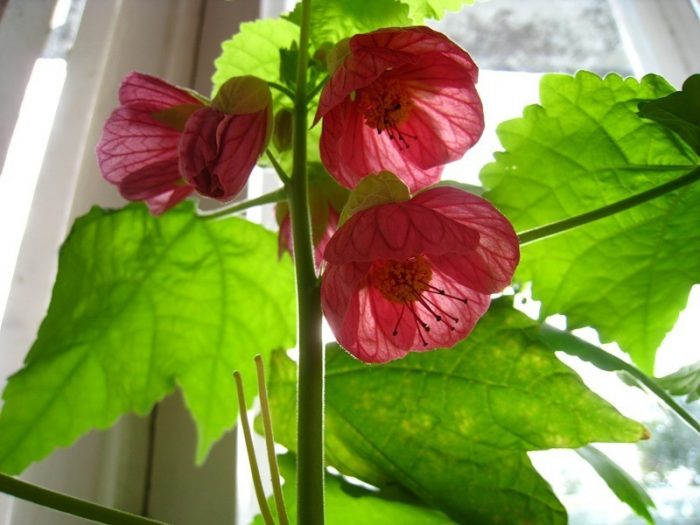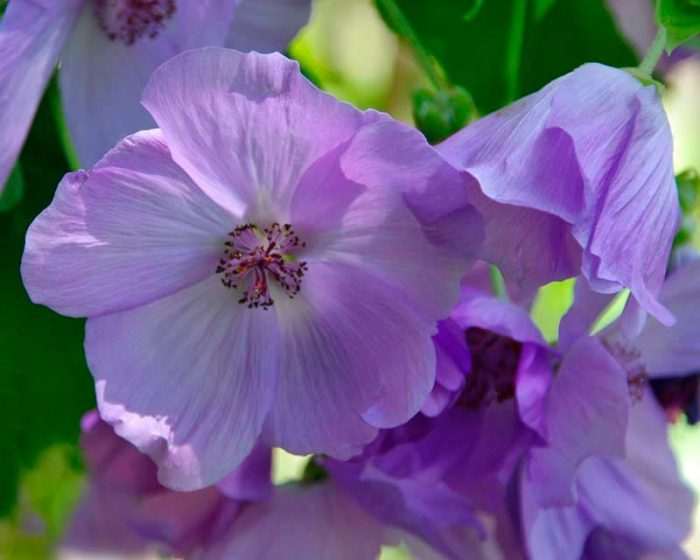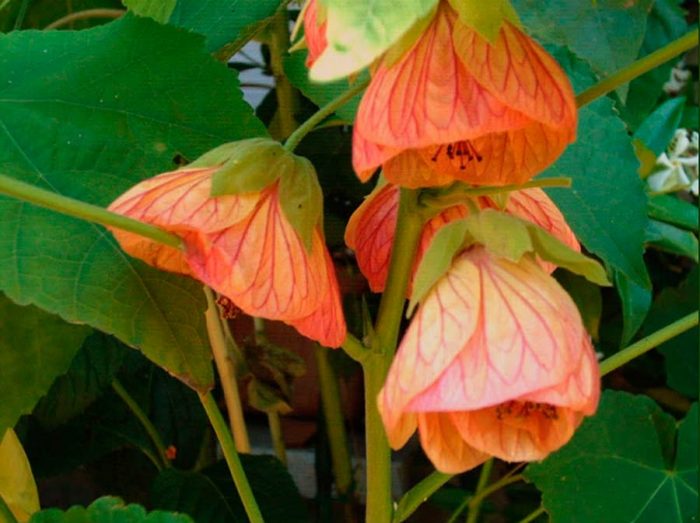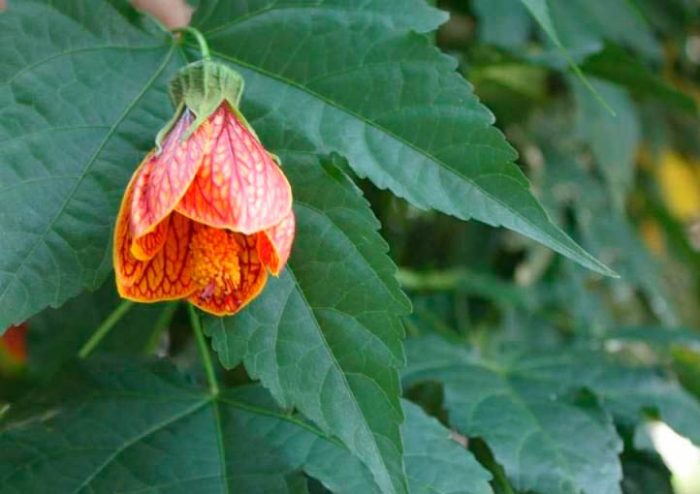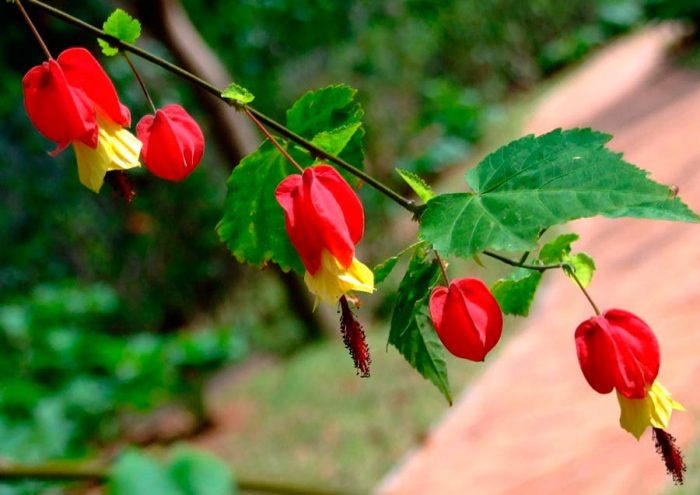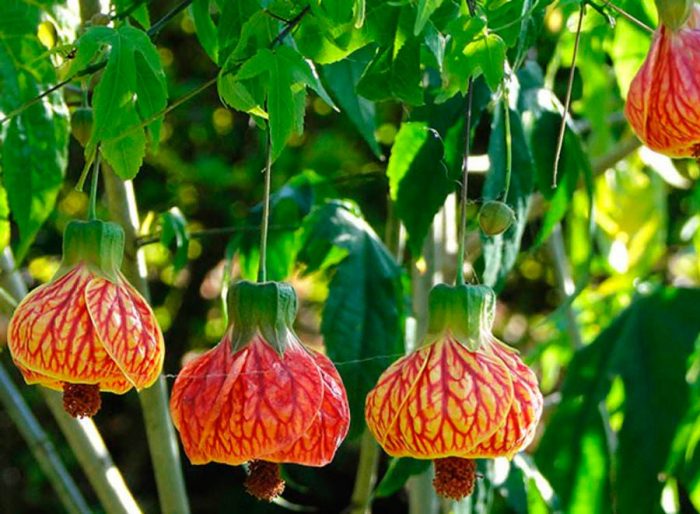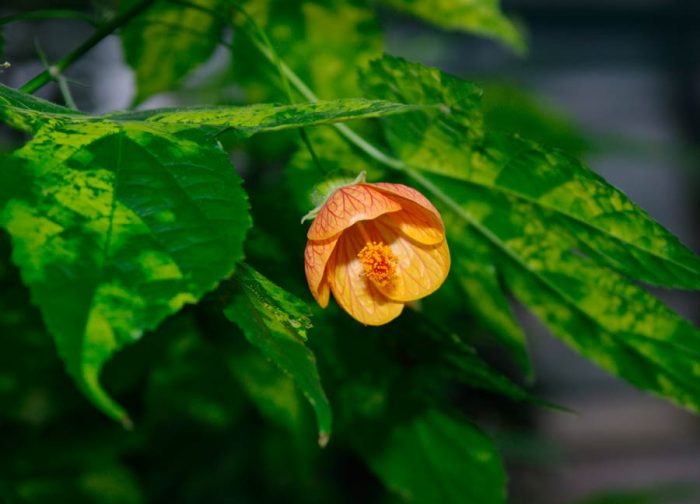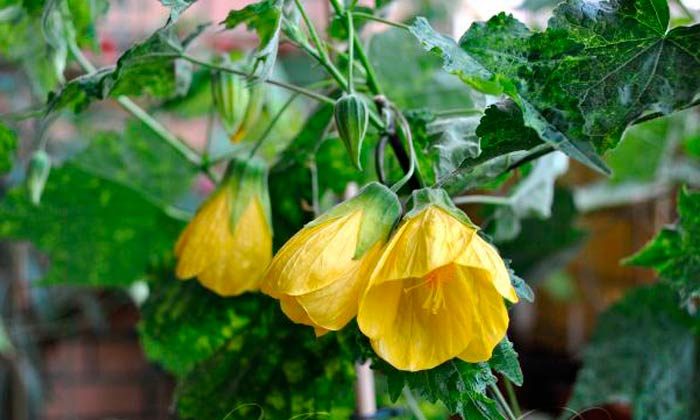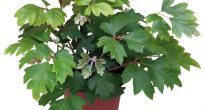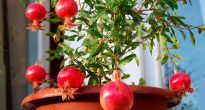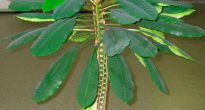The plant abutilon (Abutilon) is also called "giving shade" or indoor maple, this is due to the fact that its leaf plates are very similar to maple foliage. Also, this plant is called "cable car", since its fibrous mass in India is used to make ropes, as well as burlap. Abutilon Mill (belonging to the genus Abutilon) has about 100 species of shrubs of the Malvov family, in nature such a plant can be found in subtropical and tropical zones. Strongly branching shrubs are decorated with 3-5 lobed leaf plates, reaching about 10 centimeters in length, they have graceful cutouts, which make them look like maple foliage. Bell-shaped flowers are collected in several pieces or single. There are garden forms, as well as varieties with yellow or red flowers, with a large number of stamens, and also with variegated foliage. The flowering of hybrid forms is longer, they can be painted in different colors and color shades, and they also have different forms of foliage and flowers. Most often, such a shrub is grown in winter gardens or large rooms. If you want abutilon to bloom all year round, then you can pick up different types of such a plant. Such a shrub is ideal for experimentation: species with variegated leaves can be grafted onto species with green foliage.
Content
- 1 Brief description of cultivation
- 2 Home care for abutilon
- 3 Reproduction methods
- 4 Possible problems
- 5 Types of abutilon with photos and names
- 5.1 Abutilon grape-leaved (Abutilon vitifolium)
- 5.2 Abutilon hybrid (Abutilon hybridum)
- 5.3 Abutilon Darwin (Abutilon darwinii = hildenbrandii)
- 5.4 Abutilon megapotmicum (Abutilon megapotmicum), or amazonian abutilon
- 5.5 Abutilon pictum, or Abutilon striatum, or striped abutilone
- 5.6 Abutilon sellowianum
- 5.7 Abutilone Marmoratum
- 5.8 Abutilon variegata
Brief description of cultivation
- Bloom... Abutilon blooms in April and fades in November.
- Illumination... Grows well in bright sunlight or light shade.
- Temperature regime... During the growing season it is about 25 degrees, and in winter from 12 to 15 degrees.
- Watering... From the first days of spring to autumn it is necessary to water abundantly, and in winter the upper layer of the substrate between watering should have time to dry out to ¼ of the depth.
- Air humidity... Should be elevated.The foliage must be systematically moistened with a sprayer.
- Fertilizer... During active growth and during the flowering period, the plant is fed 2 times a month, using organic matter or mineral fertilizers for this.
- Dormant period... This period is not pronounced, however, from November to March, there is a slowdown in all processes in the bush.
- Transfer... The bush is transplanted in the spring before intensive growth begins. Young specimens are transplanted every year, and adult bushes are transplanted once every 3 years.
- Soil mixture... Should be slightly acidic or neutral (pH approximately 6.0). It should include humus and leafy earth, as well as sand (2: 2: 1).
- Reproduction... Use the seed method and cuttings.
- Harmful insects... Thrips, spider mites, mealybugs, scale insects, aphids and whiteflies.
- Diseases... If the bush is improperly looked after, then the leaves may fly around it or root rot will develop.
Home care for abutilon
Illumination
Abutilon, also called indoor maple, when grown indoors, is an unpretentious plant, but it can suffer from drafts. As for the choice of the place, it should be either well lit or slightly shaded, while the bush will not be affected even by several hours of direct light. In summer, it is recommended to transfer the bush to the street, but you need to choose a place so that it is protected from precipitation, gusts of wind and a sharp change in lighting, otherwise all flowers and leaf plates can fly around from the abutilon. In winter, the flower needs good lighting and, if necessary, it can be provided with fluorescent lighting.
Temperature regime
To grow such a shrub at home, it needs to provide a certain temperature regime. So, in the summer, the air temperature in the room should be about 25 degrees, and in the winter it needs a coolness of 12 to 15 degrees. It should be borne in mind that the room should not be colder than 12 degrees, otherwise all the foliage will fly from the bush.
How to water properly
From the first days of spring to autumn, the bush should be watered regularly and abundantly, while experts advise to systematically moisturize the foliage from a spray bottle. In winter, it is watered only after the top layer of the substrate is thoroughly dry, while in the cold season the foliage is moistened with a sprayer less often than in summer.
Fertilizer
During the flowering and active growth period, indoor maple is recommended to be fed 2 times a month, and organic or mineral fertilizers are used for this.
Pruning
If the shrub is provided with proper care, then during the spring and summer period it grows strongly. Therefore, in order for the crown to be compact and effective, in the last winter weeks, the bush should be cut to ½ part of the height, while during intensive growth all unnecessary and weak stems are removed from it, and the crown should not be excessively thickened. Abutilon will need a support garter.
Abutilon transplant
When growing this shrub indoors, it must be transplanted regularly, this procedure is carried out in the spring before the flowers appear. Young bushes are transplanted annually, and adults - once every 2 or 3 years. The soil mixture should be neutral or slightly acidic (pH about 6.0), its composition should include 1/3 of the leaf, turf and humus soil, and sand should be added to it. When choosing a new pot, it must be borne in mind that it should be only 20 mm larger in diameter than the old one, the fact is that the abundant flowering of abutilone can be seen only if its root system is cramped in the pot. This shrub can be grown hydroponically.


Watch this video on YouTube
Reproduction methods
For reproduction of abutilon, they resort to the seed method, and also for this they use low-lignified cuttings.
Growing from seeds
Seeds are sown at the beginning of the spring period, while using a soil mixture, which should include peat and sand. They are deepened by only half a centimeter. Crops must be provided with daily ventilation and spraying, they are placed in a relatively warm place (from 16 to 20 degrees). The first seedlings should appear in about 20 days. When growing abutilone from seeds, it should be borne in mind that splitting of parental traits is observed in seedlings. Therefore, seed propagation is not suitable for variegated varieties.


Watch this video on YouTube
Reproduction of abutilon by cuttings
Such a plant can be propagated by cuttings in the spring. For cutting the cuttings, the tips of young shoots are used, on each segment there should be 3 leaf plates, and their length can vary from 10 to 12 centimeters. They need to cut off all the buds, and then plant them in a soil mixture consisting of sand and peat, which should be moist all the time. At the same time, cuttings can be rooted in water at a temperature of 21 to 23 degrees for 30 days. In order for the cuttings to take root faster, you need to make a mini-greenhouse. After rooting, the cuttings are planted in pots up to 70 mm in diameter. As cuttings, you can use the stems that remained after pruning.
Possible problems
Abutilon drops buds and leaves
Abutilon can shed foliage and buds due to sudden changes in temperature or due to the fact that it is not watered correctly (the bush does not have enough water or, on the contrary, there is stagnation of liquid in the substrate).
Abutilone leaves turn pale
The flower lacks light. In this case, the bush must be transferred to a well-lit place, however, it must be gradually taught to more intense lighting, for this, at first, it is placed in the light for only 1–2 hours, then the time is gradually increased. In the event that there is no well-lit window sill in the room, then the shrubs will need fluorescent lighting.
The tips of abutilone leaves dry
This can happen due to excessively low humidity in the room. On hot days in the warm season, the leaves need to be moistened with a sprayer, while taking into account that the liquid should not get on the flowers. In the cold season, when the air is greatly dried out by central heating devices, an open container filled with water is placed next to the bush to increase the humidity.
The lower leaves of abutilone fall
This is due to the lack of nutrients in the potted soil mixture. Top dressing of the bush will help to correct the situation.
Abutilon pests
Most often, spider mites, scale insects, aphids, thrips, mealybugs and whiteflies settle on the bush.
Types of abutilon with photos and names
Abutilon grape-leaved (Abutilon vitifolium)
The height of such a shrub is about 250 cm. Its stems are soft-pubescent. Green velvety large leaf plates are 3-5 lobed, their edge is pronounced serrate, and the length is about 15 centimeters. The flowers are located on pedicels, which reach about 15 centimeters in length, they are collected in 3 or 4 pieces in a brush. The corolla is broadly bell-shaped or wheel-shaped, almost round. On the surface of bluish-lilac flowers, sometimes there are streaks of a darker shade. This species blooms in May.
Abutilon hybrid (Abutilon hybridum)
A hybrid of Abutilon pictum, created by American breeders, which is also called Darwin's abutilon (Abutilon darwinii), or striped abutilon (Abutilon striatum), has many different varieties. An evergreen shrub reaches a height of about 150 cm, its shoots are covered with brown bark.3-5-lobed green leaf plates have soft pubescence, they are maple-shaped long-petiolate, and their length is about 12 centimeters. The color of the bell-shaped drooping flowers, depending on the variety, can be golden, dark red, white or red, they reach about 50 mm in length.
Abutilon Darwin (Abutilon darwinii = hildenbrandii)
Such a shrub is very rarely cultivated. The length of the silky pubescent stems is about 100 cm. On their tops there are large, three-lobed, drooping, long-petioled leaf plates, their width is from 8 to 10 centimeters, and the length is from 15 to 20 centimeters. At the bottom, 5–7 lobed leaf plates grow, while the central one is elongated. In the leaf axils, 1–3 rich orange bell-shaped flowers with red veins are formed, they reach about 50 mm in diameter. This species blooms in April – September.
Abutilon megapotmicum (Abutilon megapotmicum), or amazonian abutilon
In England this species is called Weeping Chinese Lantern, or "weeping Chinese lantern." The height of the bush is about 150 cm, its stems are thin and drooping. Bright green elongated-oval leaf plates are sometimes unevenly serrated, and their length is about 80 mm. On rather long pedicels, single flowers with a convex corolla of a tubular-ribbed shape hang, as a rule, it is deep red. The calyx consists of yellowish petals with a red spot at the base. If you take care of the bush correctly, then it will bloom all year round.
Abutilon pictum, or Abutilon striatum, or striped abutilone
This is a shrub with soft, short, almost woody stems. Heart-shaped long-petioled green leaf plates 3–6 lobed serrate along the edge, they are not pubescent, and there are torn white spots along the edges. Bell-shaped flowers on long pedicels grow in the leaf axils, their corolla is golden with red veins, it is several times longer than the calyx. Flowering is observed in August – September. This species has a variety of thompsonii Vetch: the height of the bush is about 200 cm, the toothed bare five-lobed leaf plates reach about 10 centimeters in length, there are spots of yellow color on the dark green base of the plate, large flowers about 70 mm in diameter are double or simple, yellow or reddish, blooming in June.
Abutilon sellowianum
Some growers confuse this species with hybrid abutilon, however, such a shrub is weakly branched, and its height is about 200 cm. There is pubescence on the surface of straight stems. Three-lobed leaf plates have elongated pointed lobes. On the surface of lavender flowers there are pink veins. Flowering begins in July and ends in mid-December.
Abutilone Marmoratum
It differs from other species in that it has golden-pinnate striped leaf plates. Its stems are graceful and long, so this species is cultivated as an ampelous plant, and it is also grown in a winter garden as a ground cover crop.
Abutilon variegata
It is often cultivated as an ampelous plant, while the bush is planted in a hanging planter. However, if you tie it to a support, then this species will grow as a bush. The decorative ampelous form variegata is the most effective.
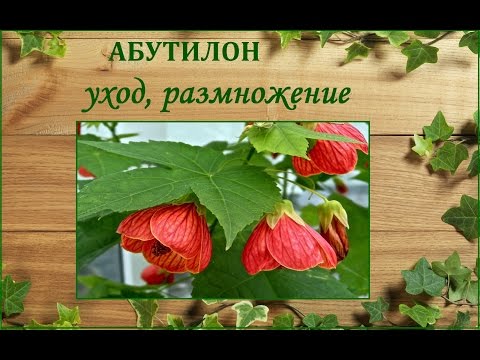

Watch this video on YouTube

